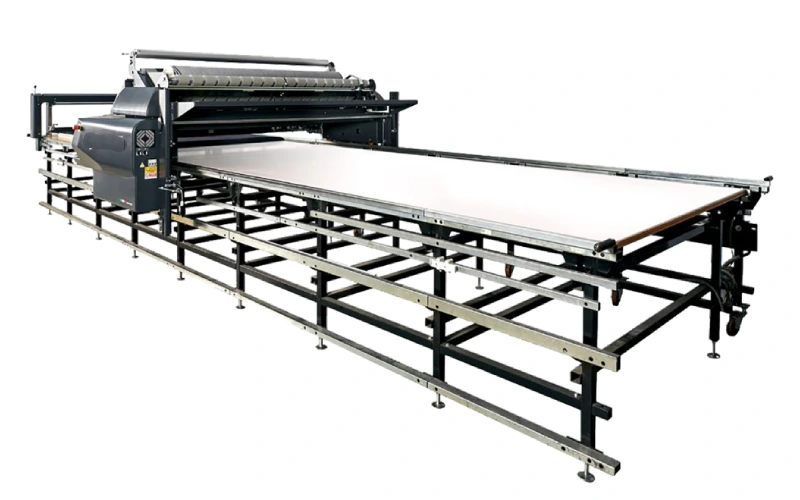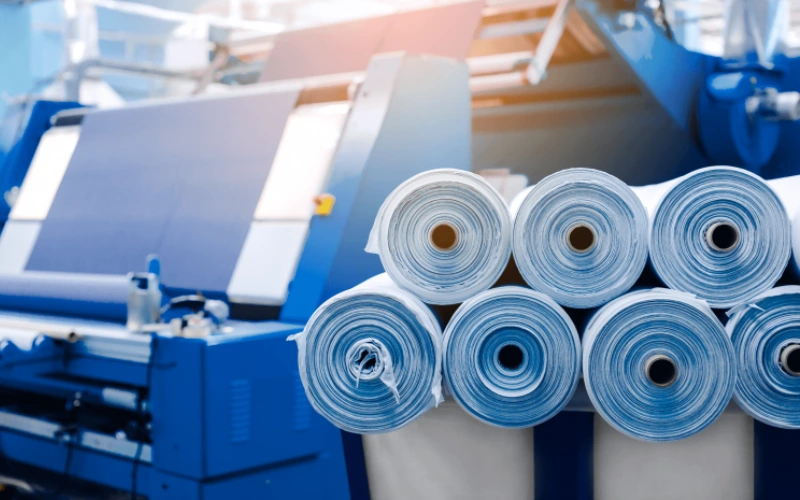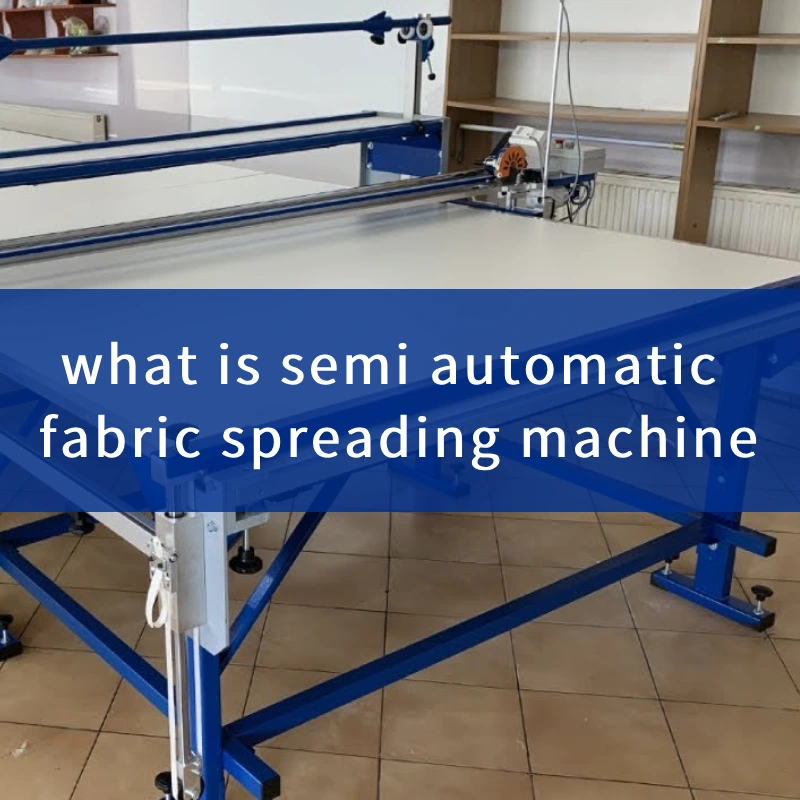A semi-automatic fabric spreading machine revolutionizes textile production by streamlining the process of preparing fabric layers for cutting.

Designed to enhance efficiency, reduce labor costs, and minimize material waste, this equipment bridges the gap between manual spreading and fully automated systems. Manufacturers like Jingchengzhiyuan prioritize precision and adaptability, ensuring these machines meet diverse industrial needs while maintaining high-quality standards.
How Does a Semi-Automatic Fabric Spreading Machine Work?
A semi-automatic fabric spreading machine, manufactured by companies like Jingchengzhiyuan, is engineered to streamline the preparation of fabric layers for cutting in textile production. Combining manual oversight with automated precision, this machine enhances efficiency while maintaining affordability for small-to-medium manufacturers.
Core Mechanism
- Fabric Loading:
Operators place fabric rolls onto the machine’s carriage. The roll is secured, and the free end is fed through a spreading head equipped with tension control rollers. - Spreading Process:
The carriage moves back and forth across the cutting table, unrolling the fabric layer by layer. Sensors detect fabric edges to ensure alignment, while adjustable tension settings prevent wrinkles or stretching. - Layer Alignment:
A programmable interface allows operators to set parameters such as layer count, length, and overlap. The machine automatically stops or adjusts speed if misalignment or fabric jams occur. - Clamping & Cutting:
Once the desired number of layers is spread, pneumatic clamps secure the fabric ends. Operators then manually trim excess material before transferring the stack for cutting.
Key Components
- Spreading Head: Controls fabric tension and alignment via motorized rollers.
- Carriage System: Moves horizontally on rails to distribute fabric evenly.
- Sensors: Optical or infrared sensors monitor edge alignment and fabric integrity.
- User Interface: A touchscreen panel enables easy adjustments for different fabric types (e.g., knits, woven, technical textiles).
Advantages of Semi-Automatic Fabric Spreaders
Semi-automatic fabric spreaders, such as those manufactured by Jingchengzhiyuan, offer transformative benefits for textile production. These machines balance automation and manual control, making them ideal for manufacturers seeking efficiency without the complexity of fully automated systems.
1. Enhanced Productivity
Semi-automatic spreaders operate 3–5 times faster than manual methods. The automated carriage system moves fabric rolls seamlessly across cutting tables, reducing downtime between layers. Operators can focus on quality checks rather than repetitive tasks.
2. Precision & Waste Reduction
Advanced sensors ensure fabric layers are aligned without wrinkles or overlaps. Jingchengzhiyuan’s models feature adjustable tension control, minimizing material stretching or tearing. This precision cuts fabric waste by up to 15%, lowering production costs.
3. Versatility
These machines handle diverse fabrics, from delicate chiffon to heavy-duty technical textiles. Programmable settings allow quick adjustments for knitwear, laminated materials, or upholstery fabrics, supporting multi-product manufacturing.
4. Ergonomic Design
By automating strenuous tasks like manual fabric lifting and spreading, these machines reduce physical strain on workers. Jingchengzhiyuan integrates user-friendly interfaces and low-noise operation, enhancing workplace safety and comfort.
5. Cost-Effectiveness
Semi-automatic spreaders require less upfront investment than fully automated systems. They also consume minimal energy, with Jingchengzhiyuan’s models utilizing efficient motors to reduce power costs.
6. Scalability for SMEs
Small-to-medium manufacturers benefit from streamlined workflows without overextending budgets. The machines adapt easily to fluctuating order volumes, making them ideal for growing businesses.
7. Durability & Support
Jingchengzhiyuan prioritizes robust construction, using wear-resistant components to ensure longevity. Coupled with responsive technical support and spare parts availability, downtime is minimized.
Applications in the Textile Industry

Semi-automatic fabric spreaders, such as those developed by Jingchengzhiyuan, play a pivotal role across diverse textile sectors by optimizing fabric preparation for high-volume cutting. Their precision, speed, and adaptability make them indispensable in the following applications:
1. Apparel Manufacturing
In garment production, semi-automatic fabric spreaders ensure flawless layering of materials like cotton, polyester, and blended fabrics. They prepare stacks for cutting shirts, dresses, uniforms, and sportswear with consistent alignment, minimizing errors in pattern matching. For stretchy knits or delicate silks, Jingchengzhiyuan’s machines adjust tension settings to prevent distortion, ensuring accurate cuts. This efficiency is critical for fast-fashion brands requiring rapid turnaround and minimal waste.
2. Home Textiles
Producing bed linens, curtains, and upholstery demands handling wide, heavy fabrics. Semi-automatic spreaders streamline these tasks by evenly distributing thick materials like jacquard weaves or quilted textiles. The machines’ programmable length settings allow operators to customize layers for oversized items (e.g., king-sized bedsheets), while edge sensors maintain straight alignment. This reduces fabric slippage and misalignment, which are common challenges in bulk home textile manufacturing.
3. Automotive Interiors
Automotive upholstery requires extreme precision for seat covers, door panels, and headliners. Semi-automatic spreaders handle technical fabrics like laminated textiles, faux leather, and flame-retardant materials. Jingchengzhiyuan’s models feature specialized clamping systems to secure slippery or coated fabrics, ensuring wrinkle-free layers. This precision is vital for maintaining aesthetic consistency and meeting stringent automotive industry standards.
4. Technical Textiles
Beyond these sectors, semi-automatic spreaders support medical textiles (e.g., PPE gowns), industrial fabrics (e.g., conveyor belts), and geotextiles. Their ability to process heavy, non-woven, or composite materials makes them versatile for niche applications requiring durability and exactitude.
Choosing the Right Machine
When selecting a semi-automatic fabric spreading machine, consider:
- Fabric Compatibility: Ensure the machine supports your material type (stretchy, delicate, etc.).
- Table Length: Match the machine’s capacity to your workspace.
- Ease of Maintenance: Opt for models with accessible parts and local technical support.
Maintenance Tips
- Clean rollers and sensors weekly to prevent dust buildup.
- Lubricate moving parts monthly.
- Calibrate tension settings periodically for consistent performance.
The Future of Fabric Spreading
Advancements in AI and IoT are transforming semi-automatic machines. Future models may feature self-diagnostic tools, real-time data tracking, and enhanced automation for seamless integration into smart factories.
Why Invest in a Semi-Automatic Spreader?
For businesses seeking a balance between affordability and efficiency, semi-automatic fabric spreading machines offer a practical solution. They optimize workflow without the high costs of fully automated systems, making them ideal for SMEs aiming to scale production.
FAQ
1. What is a semi-automatic fabric spreading machine?
A semi-automatic fabric spreading machine is a textile production tool designed to unroll, align, and layer fabric efficiently on a cutting table. It combines manual oversight with automated functions, such as tension control and edge detection, to prepare fabric for bulk cutting. This equipment reduces labor time and minimizes material waste compared to fully manual processes.
2. What are the key advantages of using a semi-automatic fabric spreader?
- Faster workflow: Spreads fabric 3–5 times quicker than manual methods.
- Precision: Sensors ensure wrinkle-free, evenly aligned layers.
- Cost-effective: Ideal for small-to-medium manufacturers needing efficiency without the high cost of full automation.
- Versatility: Handles delicate, stretchy, or thick fabrics with adjustable settings.
3. How often should I maintain a semi-automatic fabric spreading machine?
Regular maintenance is critical:
- Daily: Clean fabric dust from rollers and sensors.
- Monthly: Lubricate moving parts and inspect belts.
- Annually: Schedule professional calibration to ensure tension accuracy.
Most manufacturers, like BN PACK, provide maintenance guidelines and spare parts support.
4. Can this machine handle technical fabrics like laminated or coated materials?
Yes. Modern semi-automatic fabric spreaders are designed for versatility. Look for models with adjustable clamping pressure and programmable tension settings to accommodate technical fabrics. Always confirm compatibility with your supplier before purchase.
5. Is a semi-automatic fabric spreader suitable for small businesses?
These machines offer a cost-efficient middle ground between manual labor and full automation. They require minimal training, reduce labor costs, and optimize material usage, making them ideal for small workshops or growing manufacturers.
Conclusion
The semi-automatic fabric spreading machine is a cornerstone of modern textile manufacturing. By combining human oversight with mechanical precision, it empowers manufacturers to achieve faster turnaround times, reduce waste, and maintain competitive edge. Brands like BN PACK continue to innovate, delivering machinery that adapts to evolving industry demands while prioritizing user-friendly operation and durability.

